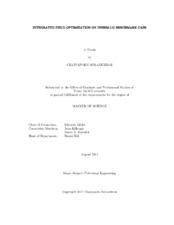| dc.contributor.advisor | Gildin, Eduardo | |
| dc.creator | Suranetinai, Chaiyaporn | |
| dc.date.accessioned | 2018-02-05T21:17:03Z | |
| dc.date.available | 2018-02-05T21:17:03Z | |
| dc.date.created | 2017-08 | |
| dc.date.issued | 2017-07-13 | |
| dc.date.submitted | August 2017 | |
| dc.identifier.uri | https://hdl.handle.net/1969.1/165938 | |
| dc.description.abstract | Integrated field optimization is known to be a useful tool to evaluate oil and gas asset
performance and maximize asset’s value. However, it is not an easily achievable task due
to its complexity. This study aims to assess the potential of the integrated optimization
on UNISIM-I-D benchmark case, and a surface network model. The objective of the
optimization is to maximize the asset’s Net Present Value by choosing the optimal surface
facilities capacity. The integration of the model or being called as coupling is carried out
in INTERSECT field management software while the reservoir is modeled in ECLIPSE
reservoir simulator and the surface network is modeled in PIPESIM steady-state flow
simulator. MATLAB codes are used to operate all the commercial software and
automatically analyze the results obtained from them. Optimizations are performed on
MATLAB Optimization Toolbox™.
The reservoir is treated as a black oil model while the surface network is a steady-state
simulation. The partially implicit coupling scheme is selected to be used to optimize the
computational effort and maintain the accuracy of the results. The purpose of having
MATLAB codes executing the commercial software is that these codes will be able to be
directly applied to the industry’s working resources.
Simulations are run in both uncoupled and coupled fashion. Surface facilities limits from
UNISIM-I-H model are used in a base case. Base case results from the uncoupled and
coupled cases are identical which confirm the accuracy of the coupled simulations and signify that at the base case conditions, effects from the surface network are not significant.
The optimal results show 3-7% improvement in the asset’s Net Present Value while
optimizing the oil processing capacity, water processing capacity, and water injection
capacity. Although some cases may have the same oil recovery at the end of production
period, the asset’s Net Present Values are different. Cumulative water production,
cumulative water injection, and production timing affect the final asset’s value in the
economic point of view. The optimal surface facilities capacity ends up at the pre-defined
lower boundary which can be implied that there is a bottleneck in the well performance. | en |
| dc.format.mimetype | application/pdf | |
| dc.language.iso | en | |
| dc.subject | Integrated Field Optimization | en |
| dc.subject | Optimization | en |
| dc.subject | Coupling | en |
| dc.subject | Integrated Asset Modeling | en |
| dc.subject | Reservoir Simulation | en |
| dc.subject | Network Simulation | en |
| dc.title | Integrated Field Optimization on UNISIM-I-D Benchmark Case | en |
| dc.type | Thesis | en |
| thesis.degree.department | Petroleum Engineering | en |
| thesis.degree.discipline | Petroleum Engineering | en |
| thesis.degree.grantor | Texas A & M University | en |
| thesis.degree.name | Master of Science | en |
| thesis.degree.level | Masters | en |
| dc.contributor.committeeMember | Killough, John | |
| dc.contributor.committeeMember | Barrufet, Maria A. | |
| dc.type.material | text | en |
| dc.date.updated | 2018-02-05T21:17:03Z | |
| local.etdauthor.orcid | 0000-0002-0745-8781 | |


